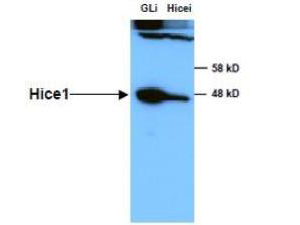Anti-HICE1 Secondary Antibody
Rabbit Polyclonal, Unconjugated
- 产品详情
- 实验流程
- 背景知识
| Description | Anti-HICE1 (Rabbit) Antibody |
|---|---|
| Host | Rabbit |
| Conjugate | Unconjugated |
| Target Species | Human |
| Reactivity | Human |
| Clonality | Polyclonal |
Application
| WB |
| Physical State | Liquid (sterile filtered) |
| Host Isotype | Antiserum |
| Buffer | 0.02 M Potassium Phosphate, 0.15 M Sodium Chloride, pH 7.2 |
| Immunogen | Anti-HICE1 was prepared from whole rabbit serum produced by repeated immunizations with a recombinant full length Hice1 protein. |
| Stabilizer | None |
| Preservative | 0.01% (w/v) Sodium Azide |
| Shipping Condition | Dry Ice |
|---|---|
| Application Note | This antiserum has been tested for use in ELISA and western blotting using a full length recombinant Hice1 protein. Specific conditions for reactivity and detection of Hice1 should be optimized by the end user. Expect a band approximately ~45 kDa in size corresponding to Hice1 by Western Blotting in the appropriate cell lysate or extract. |
| Purity | This product was adsorbed against GST from monospecific antiserum by immunoaffinity chromatography. This antibody reacts with endogenous Hice1 protein. A BLAST analysis was used to suggest reactivity with Hice1 from human based on a 100% homology with the immunizing sequence. Expect reactivity with Hice1 from chimpanzee, Sumatran orangutan based on a 90% homology with the immunizing sequence. Cross-reactivity with Hice1 from other sources has not been determined. |
| Storage Condition | Store vial at -20° C prior to opening. Aliquot contents and freeze at -20° C or below for extended storage. Avoid cycles of freezing and thawing. Centrifuge product if not completely clear after standing at room temperature. This product is stable for several weeks at 4° C as an undiluted liquid. Dilute only prior to immediate use. |
| Precautions Note | This product is for research use only and is not intended for therapeutic or diagnostic applications. |
For Research Use Only. Not For Use In Diagnostic Procedures.
Provided below are standard protocols that you may find useful for product applications.
BACKGROUND
This antibody is designed, produced, and validated as part of a collaboration between Rockland and the National Cancer Institute (NCI) and is suitable for Cancer, Immunology and Nuclear Signaling research. Hice1 contributes to the mitotic spindle assembly, maintenance of centrosome integrity and completion of cytokinesis as part of the HAUS augmin-like complex. Normal bipolar spindle formation is critical for accurate chromosome segregation and proper mitotic progression. Failure in this event leads to spindle checkpoint activation and chromosome missegregation that ultimately leads to aneuploidy. Hice1 binds to microtubules directly, and promotes spindle integrity and chromosome stability. Hice1 has also shown to play an important role in targeting the ?TuRC complex to the mitotic spindle, a step that appears to be required for spindle-mediated microtubule generation and normal chromosome segregation. The HAUS augmin-like complex's interaction with microtubules is strong during mitosis, while it is weak or absent during interphase. During interphase, it is primarily cytoplasmic, associating with centrosomes and with the mitotic spindles, preferentially at the spindle pole vicinity. During anaphase and telophase, it additionally associates with the spindle midzone and midbody, respectively. Further characterization of the function of Hice1 will likely be important for better understanding the mechanism of normal mitotic progression and high fidelity chromosome segregation.
终于等到您。ABCEPTA(百远生物)抗体产品。
点击下方“我要评价 ”按钮提交您的反馈信息,您的反馈和评价是我们最宝贵的财富之一,
我们将在1-3个工作日内处理您的反馈信息。
如有疑问,联系:0512-88856768 tech-china@abcepta.com.























 癌症的基本特征包括细胞增殖、血管生成、迁移、凋亡逃避机制和细胞永生等。找到癌症发生过程中这些通路的关键标记物和对应的抗体用于检测至关重要。
癌症的基本特征包括细胞增殖、血管生成、迁移、凋亡逃避机制和细胞永生等。找到癌症发生过程中这些通路的关键标记物和对应的抗体用于检测至关重要。 为您推荐一个泛素化位点预测神器——泛素化分析工具,可以为您的蛋白的泛素化位点作出预测和评分。
为您推荐一个泛素化位点预测神器——泛素化分析工具,可以为您的蛋白的泛素化位点作出预测和评分。 细胞自噬受体图形绘图工具为你的蛋白的细胞受体结合位点作出预测和评分,识别结合到自噬通路中的蛋白是非常重要的,便于让我们理解自噬在正常生理、病理过程中的作用,如发育、细胞分化、神经退化性疾病、压力条件下、感染和癌症。
细胞自噬受体图形绘图工具为你的蛋白的细胞受体结合位点作出预测和评分,识别结合到自噬通路中的蛋白是非常重要的,便于让我们理解自噬在正常生理、病理过程中的作用,如发育、细胞分化、神经退化性疾病、压力条件下、感染和癌症。






